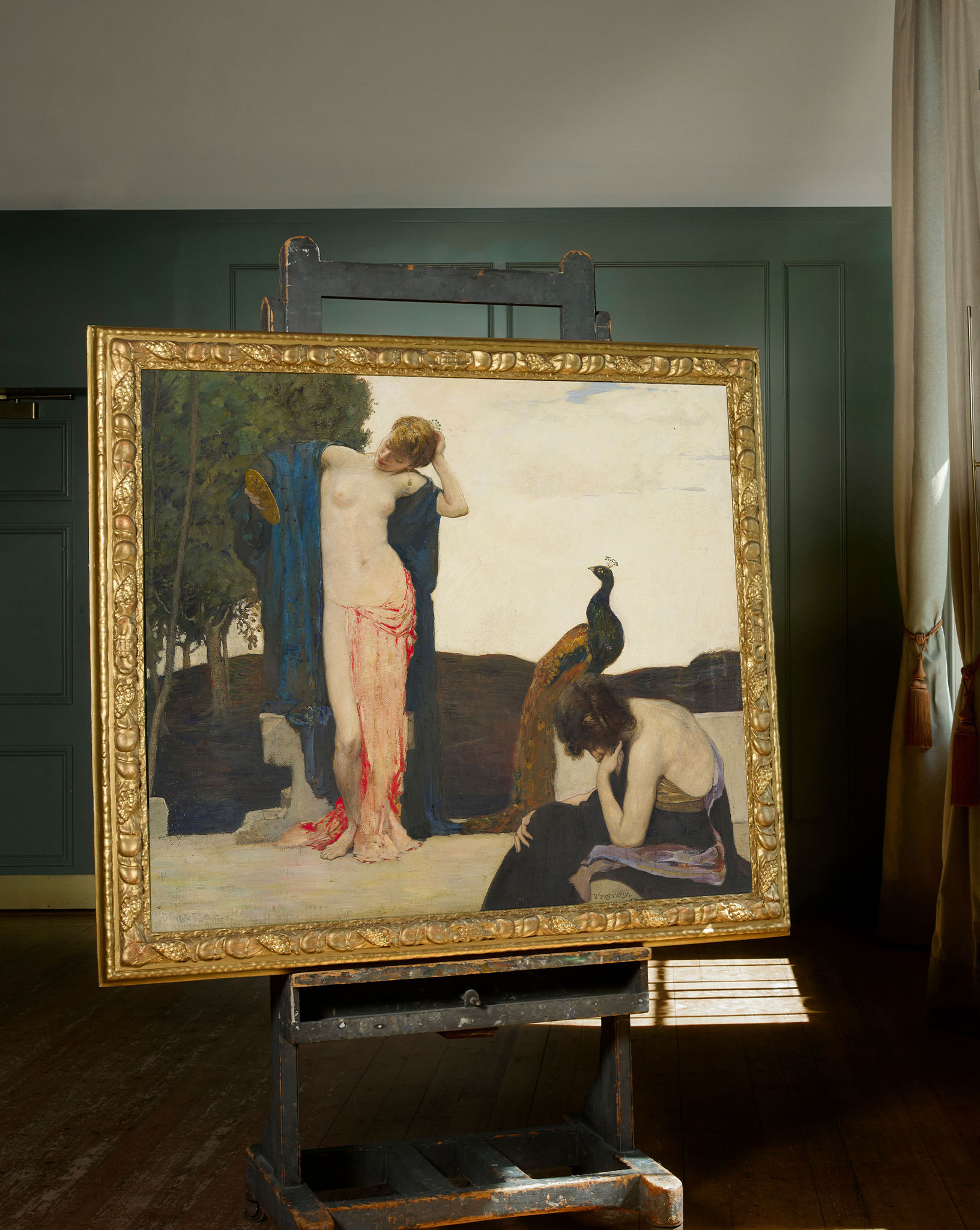DAVID FORRESTER WILSON R.S.A. (SCOTTISH 1873-1950)
VANITY
£35,200
Scottish Paintings & Sculpture
Auction: Evening Sale | Lots 112- 206 | Thursday 05 June from 6pm
Description
Signed and dated 1918 twice, inscribed to stretcher verso ‘Forrester Wilson, School of Art, 167 Renfrew St, Glasgow’, with a preliminary sketch verso, oil on canvas
Dimensions
115cm x 130cm (43.25in x 51.25in)
Provenance
Exhibited:
Royal Scottish Academy, Edinburgh, 1919, no.125
Footnote
David Forrester Wilson is a difficult artist to pin down. In recent years, his name has become, rather surprisingly, associated with the great Pop Art icon Andy Warhol, who it turns out was a great fan of his work and owned a selection of his paintings. They were included in the auction of the artist’s personal collection in 1988 and one particularly Symbolist composition, The Wind, which had been displayed prominently at The Factory, went on to achieve $110,000, ten times its pre-sale estimate. Vanity allows comparisons to this work in its rich celebration of beauty, colour and sensuality - quite at odds with the more naturalistic landscapes that Forrester Wilson also produced in his career.
Despite the evocative nature of his Symbolist paintings and the rather eclectic nature of his contemporary collectors, Forrester Wilson himself lived a very stable existence, living in Milngavie, Ayr, the city of Glasgow and ultimately Islay over the course of his life, as he painted, exhibited and taught. The son of a lithographer, Forrester Wilson trained at the Glasgow School of Art and travelled in Europe, as advised by his teachers to develop his practice, before ultimately joining the teaching staff, working under Maurice Greiffenhagen and eventually succeeding him on his retirement (see Lot 150). Forrester Wilson looked to a wide range of artists for inspiration, from his original teacher the Belgian Symbolist painter Jean Deville to his Scottish predecessors, the Glasgow Boys, including James Guthrie and John Lavery, as well as his contemporaries, including The Four: Charles Rennie Mackintosh, Frances and Margaret Macdonald and Herbert MacNair. Forrester Wilson was also influenced by the work of artists including J.M. Whistler and Jules Bastien-Lepage and this open-mindedness is evidence of his own desire to evolve and learn, both in his own practice and as he taught the next generation.
The artist was committed to exhibiting his work and made regular submissions to both the Royal Scottish Academy in Edinburgh and the Royal Glasgow Institute, as well as exhibiting internationally in Chicago and Pittsburgh, U.S.A. Throughout the 1920s Forrester Wilson exhibited a number of works with poetic titles that evoked concepts, sounds and sensations, rather than a particular subject or narrative, aligning with the broader ideals of the wider Symbolist movement. A reaction against previously prevailing naturalist and realistic depictions of the world, Symbolist works were concerned more with feeling and atmosphere, conveying emotion across art, poetry and literature. It is maybe not surprising that this was painted in 1918, when beautiful allegorial scenes offered a means for viewers to escape to a haven outside of their time.
Forrester Wilson underpins the dramatic composition with skilled drawing and design, taking his life school talent out of an academic context and into the creation of this mysterious and languid scene. Classical elements are present, as well as rich colour, drawing us into this unspecified locale of light skies, dense trees and pale stone, where there is a sense of leisure and idleness in the expanse of pale skin, lush, draping fabrics and the presence of a majestic peacock, its extravagant tail just temporarily at rest.
The word ‘vanity’ is defined as ‘an excess of pride in one’s appearance or achievements’. The distinctive crest of feathers on the peacock’s head, known as the crown, is also found on the head of the standing nude, who gazes at their own reflection in the mirror. This invites us to identify the nude, too, as a ‘Peacock’, synonymous with vanity or showy behaviour to attract attention or impress. This simile also alludes to the male peacock, with its colourful tail that can be expanded like a fan, which has long symbolized vanity and pride. In the Greek myth of Narcissus, a beautiful youth is cursed by the goddess Nemesis for his vanity. He falls in love with his own reflection in a pool of water, becoming so obsessed that he wastes away from thirst and eventually transforms into the narcissus flower. This myth cautions against self-obsession and the dangers of prioritizing vanity over human empathy. This very dynamic might explain the distance between the two figures, the sitting figure’s subdued posture and her isolation from the self-obsessed nude.

